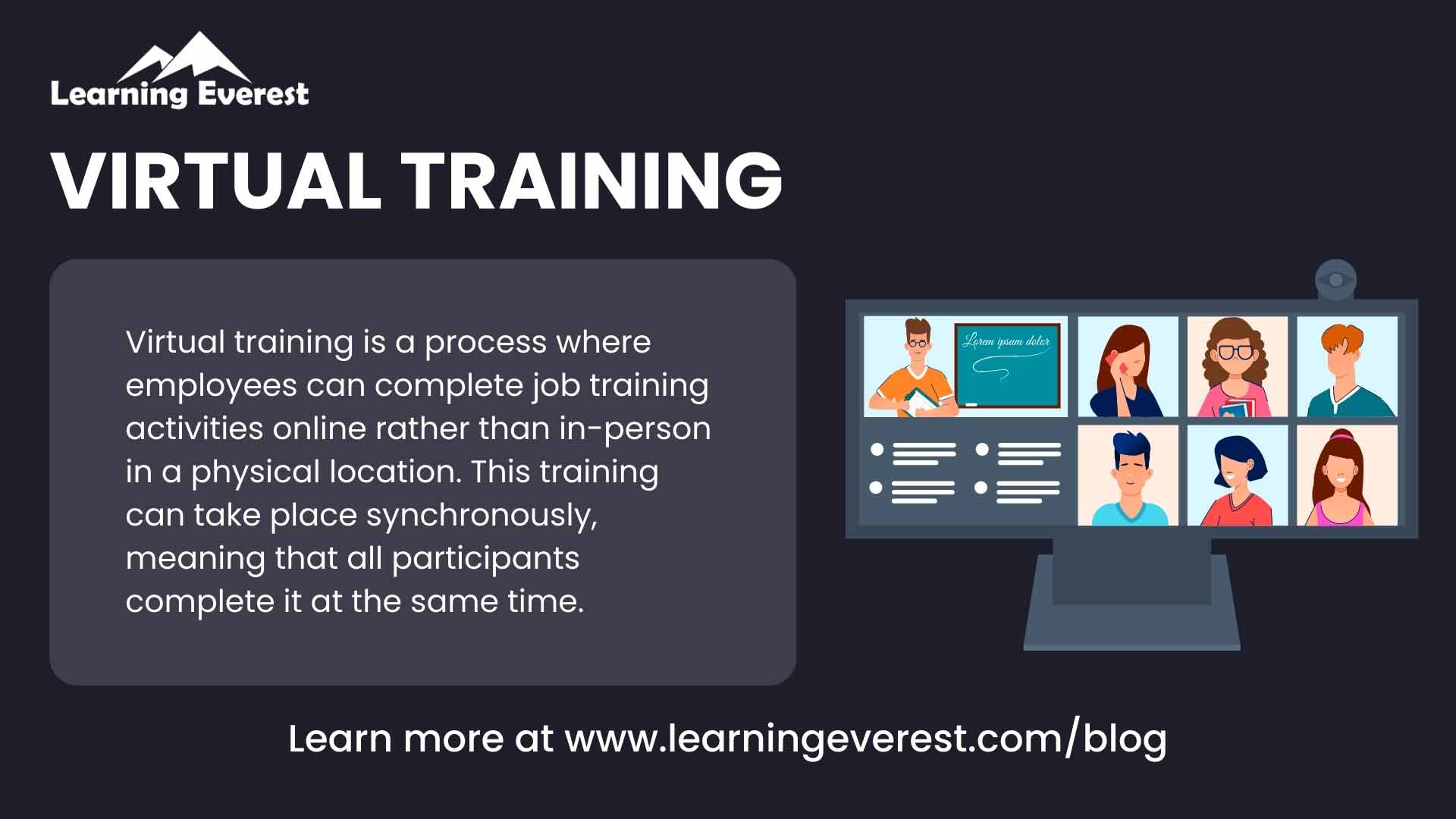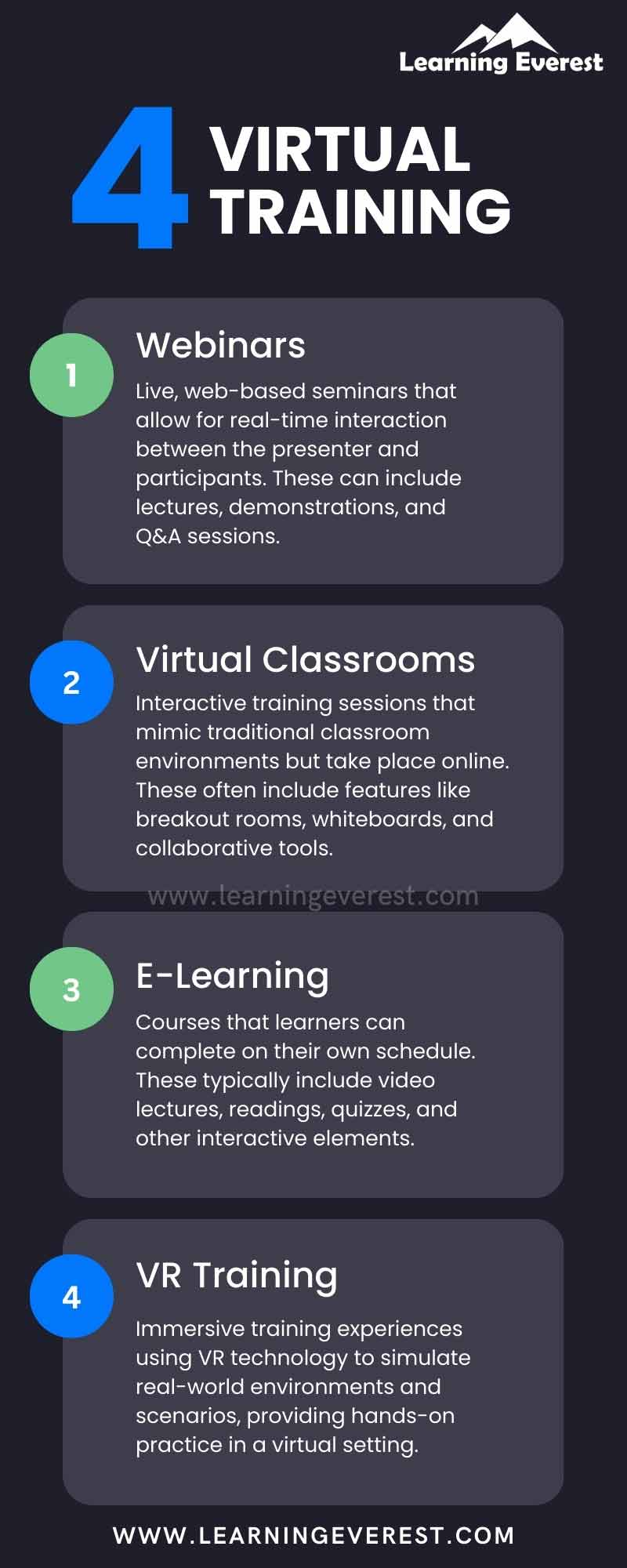What is virtual training?
Virtual training is a process where employees can complete job training activities online rather than in-person in a physical location. This training can take place synchronously, meaning that all participants complete it at the same time. One way to do this is with a web-based video chatting software or program. Virtual training can also be asynchronous. In this case, employees can complete a virtual training activity or program individually. While there may be a time limit imposed, employees can often complete these training programs at their convenience.


Virtual training
Many industries can use virtual training to help employees prepare for or advance their roles. With virtual training technologies, these companies can develop training programs that meet employee needs and organizational requirements. Depending on the organization’s goals and resources, virtual training and development programs can range in length from a brief, one-time class to regular training sessions. Some examples of virtual training could be an online workshop demonstrating how to use a new technology or a virtual skills assessment program.
Why is virtual training important?
Virtual training is important because it can allow organizations to safely and effectively train employees in various geographical locations. In situations where it isn’t possible to have all employees meet in person, virtual training can allow employees to maintain their skills and keep up with their work requirements. This can be especially important if an organization operates remotely. If most employees live in different geographical locations, virtual learning can be an efficient way to connect the whole organization. Even if employees live in the same area or an organization sometimes operates in person, virtual training opportunities can supplement employee learning.
Virtual training best practices
1. Set learner expectations
As you kick off the session, let your learners know that they should plan to actively participate throughout the program. Encourage them to turn off notifications and close other applications on their browser. You have limited time together, and they will make the most of it by focusing. This information is also helpful to include in a pre-event mail. It sets the tone for the virtual training and reminds the audience to focus.
2. Turn on video
Simply having their video on improves learners’ engagement in training sessions because they will want to appear listening, attentive, and engaged. But, encouraging participants to use video can be tricky. Here are three tips that can help:
- Set this expectation in advance in an email. Some people like to be “camera-ready,” and this advance notice helps them to be sure they have the right setup.
- You can ask participants to turn on their video at the beginning of the training session and give them a reason why it is essential.
- Thank participants who have turned on their video by mentioning their names. This positive reinforcement works wonders.
3. Engage learners within first 5 minutes
The key to an interactive virtual training session is participation and engagement. Integrate opportunities for audience participation in the opening to set their expectation that you will be asking for engagement throughout the virtual session.
4. Ask for learner engagement every 10-minutes
To keep participants engaged throughout the virtual training session, aim to engage them every 15 minutes. While it may seem like a lot, the engagements always don’t have to be formal; in fact, casual small engagements work better. This will keep learners paying more attention, since they know you could ask a question at any time. Here are some examples:
- How many of you have experience with this topic?
- On a scale of 1 to 10, how much do you already know about this topic?
- What is the first thing that pops in your mind when you think about this topic?
- Raise your hand if you’ve done this before.
- What is your biggest takeaway from this section?
5. Wait for responses
Sometimes, you may have learners who are difficult to draw out. If you ask for participation and don’t receive responses, you will need to wait until someone gives their response. If you just move on without a response, you are telling participants that they don’t have to answer your questions. Instead of moving on when you lack responses, try these three tips:
- Let the audience know that it can take some time to type their responses, so you are happy to wait a few minutes to share.
- Reframe the question; perhaps it wasn’t clear.
- Make the question easier to answer — for example, a “yes/no” question. Sometimes, it is difficult to answer more complex or vague questions in a chat.
Also, when people respond, it is important to acknowledge their responses. Using their names rewards them with attention and positively reinforces that you value about responses.
6. Create feedback loops
If you ask for feedback or questions, integrating learners’ responses into the training shows them that their feedback matters. For example, at the beginning of a topic, ask participants to rate their knowledge of that topic from a 1 to a 10. If most people respond between a 2 and a 4, you can say, “I see that a lot of you are just starting out; that’s great! I have some excellent tips for you.” Find ways to loop back to the feedback from your audience so they know that it matters, and use it to shape the way you conduct the training.
7. Begin and end in full-screen presenter mode
It can be challenging for attendees to feel engaged when looking at a slide deck. Most virtual presentation software highlights the slides and shows the presenter in a smaller view. When you stop sharing your slides, your video becomes the full-screen focus. Beginning and ending the training session with yourself in full screen will help you build a connection with your audience.
8. Be conversational with predictive reactiveness
A conversational tone and style will help you build a deeper connection with the audience. You want your learners to feel like you are speaking to them, not at them. One of the ways to build a conversational tone is with predictive reactions — reacting based on how you predict your audience will react. For example, if you tell a joke, laugh as though participants are laughing with you. If you speak about something that is difficult, assume they’ve just nodded at you, and nod back. The idea is to predict or assume their response and react accordingly. This approach creates a conversational style and acknowledges the audience.
9. Use breakout rooms
Breakout rooms are a great way to drive participation and engagement in virtual training. Some participants don’t feel comfortable speaking out in a larger group, and breakouts give everyone the opportunity to participate. Here are a few tips for effective breakouts:
- Give clear and detailed instructions so the groups know exactly what to do in their breakout.
- Appoint a leader to avoid awkwardness at the start of the discussion or activity. It could be a formal leader or someone selected randomly, like the person whose first name is closest to the top of the alphabet.
If groups are working on a task, it can be helpful to give participants time to think in advance of a group discussion. Try five minutes of solo preparation, 15 minutes of group discussion, and 10 minutes of sharing insights with the whole group.
To sum up
Virtual training is a powerful delivery format. As a virtual trainer, you must be deliberate in maintaining an engaging environment to drive participation and keep the audience motivated. The good news is that virtual training experiences can exceed the quality of in-person sessions when they’re structured properly with the right strategies.
Infographic


4 Virtual training best practices
Knowledge check!
Frequently Asked Questions (FAQs)
What is virtual training?
Virtual training is a process where employees can complete job training activities online rather than in-person in a physical location. This training can take place synchronously, meaning that all participants complete it at the same time.
Why is virtual training important?
Virtual training is important because it can allow organizations to safely and effectively train employees in various geographical locations.